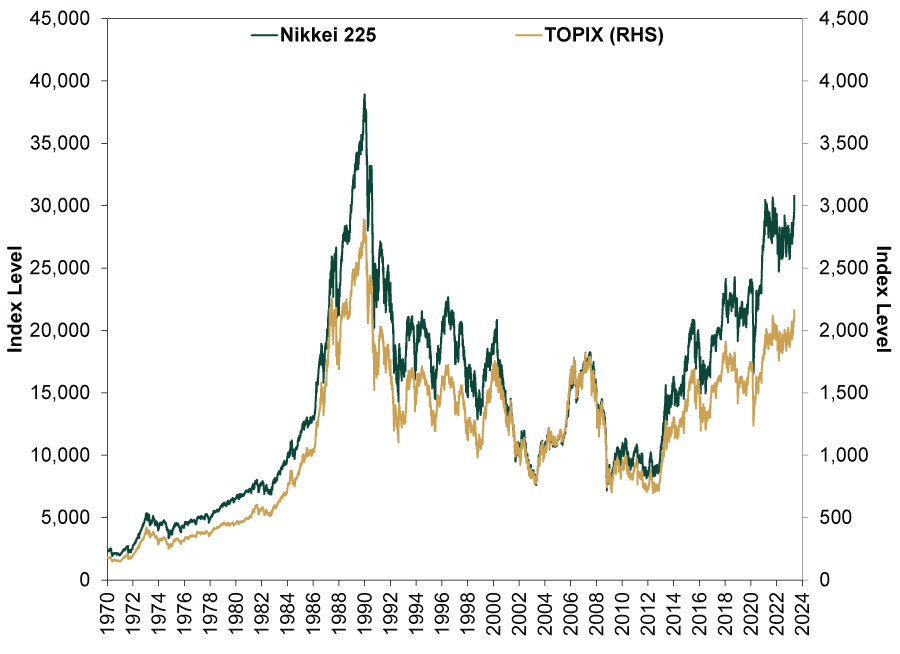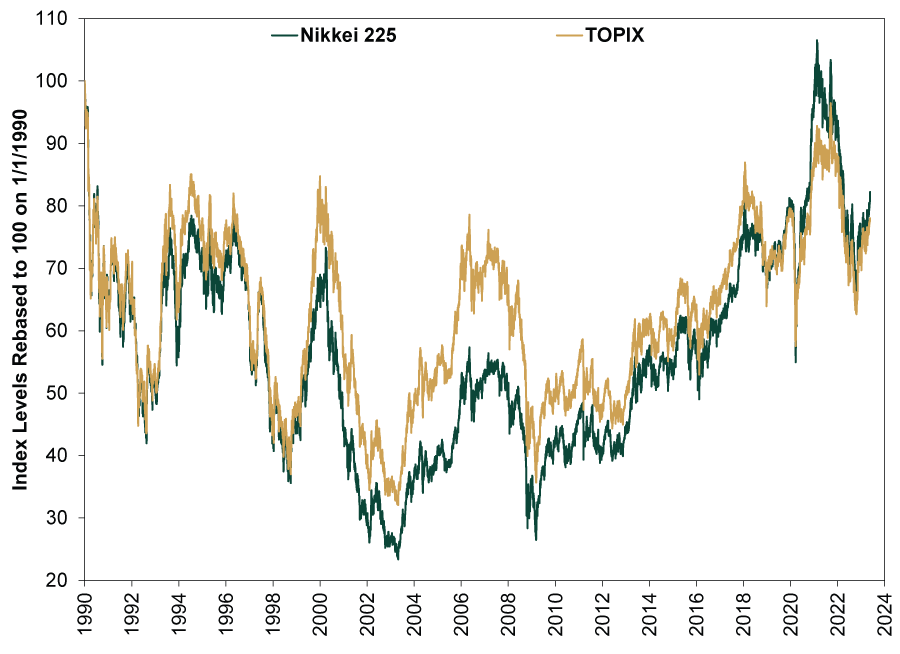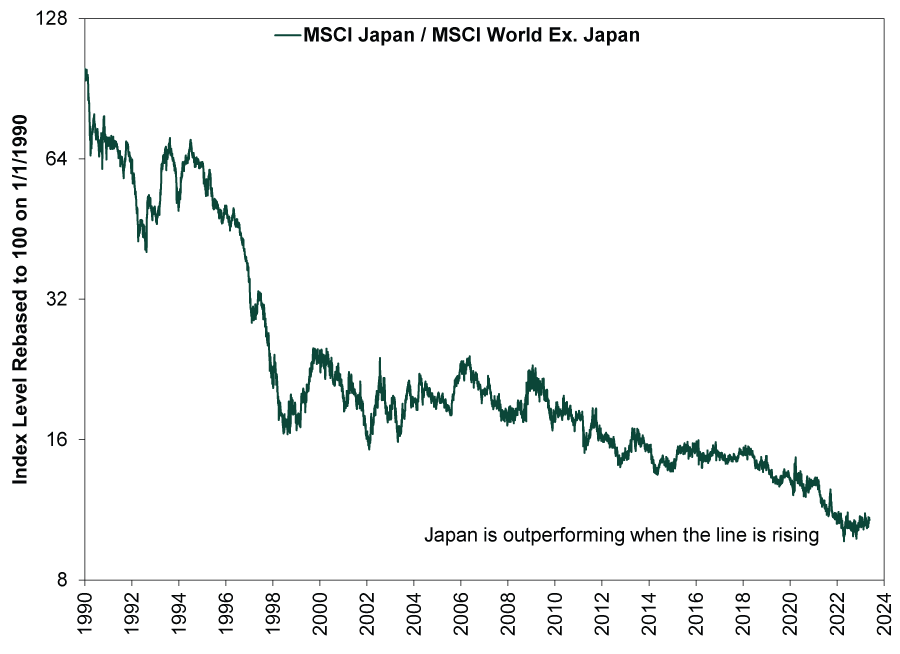Personal Wealth Management / Market Analysis
Japan’s Resurgence in Perspective
Some things to note as Japanese stocks scale generational heights.
Broad Japanese equity indexes rose to multi-decade highs last week. Coupled with some very high profile investors recently taking an interest, the climb has many headlines buzzing. While an interesting observation, we think more in-depth perspective is in order before loading up on Japan.
As Exhibit 1 shows, the Nikkei 225 (the Japanese version of America’s long-running, but archaically price-weighted DJIA) and TOPIX (Japan’s more sensibly market cap-weighted index, akin to the S&P 500) are hitting 33-year highs. Those highs were the culmination of the epic late-1980s’ bubble, which Japanese markets have yet to regain. They also preceded the country’s infamous lost decade(s).
Exhibit 1: Japanese Equities Hitting Multi-Decade Highs in Yen
Source: FactSet, as of 5/22/2023. Nikkei 225 and TOPIX price indexes in yen, 1/1/1970 – 5/19/2023.
Although these indexes remain below their respective 1990 peaks, they aren’t too far from them, which appears to be contributing to the latest attention and interest in Japan’s stock market. Supposedly, this could be signaling its days of perceived economic stagnation and chronic deflation are finally ending. Japanese markets’ recent upturn also seemingly contrasts with other developed countries’ stock markets. The MSCI World Index, while recovering since the fall, remains below its early-2022 peak, unlike Japan’s gauges.
A few things for global investors to note here, though. Japanese stocks’ apparent strength evaporates after currency conversion. In yen terms, they may have usurped 2021 highs, but in dollars, they are still off their peaks—just like other developed markets. (Exhibit 2) Global investors aren’t reaping outsized returns in Japan. Interestingly, too, the dollar-denominated Nikkei 225 surpassed its 1990 peak in 2021 (the TOPIX came close), and we didn’t see many making a fuss at the time.
Exhibit 2: Japanese Equities Deflated by Dollars
Source: FactSet, as of 5/22/2023. Nikkei 225 and TOPIX price indexes in dollars, 1/1/1990 – 5/19/2023.
Also consider MSCI Japan relative to MSCI World ex. Japan. (Exhibit 3; we use MSCI indexes here for comparison, but MSCI Japan hews very closely to the TOPIX.) If you squint, Japanese stocks’ recent outperformance is barely perceptible. Bigger bursts have come and gone in the last couple decades. This doesn’t rule out a change in trend, but so far at least, we have seen this movie before.[i]
Exhibit 3: A Reversal in Japan’s Decades-Long Relative Downtrend Isn’t Obvious
Source: FactSet, as of 5/22/2023. MSCI Japan price index divided by MSCI World Ex. Japan price index, 1/1/1990 – 5/19/2023.
Of course, all that is backward looking. Many note Japanese stocks’ “attractive” valuations and Q1 GDP improvement bode well for a continuation. But there are problems with this logic, in our view. For one, valuations aren’t predictive. Japan’s have been arguably attractive over the last decade—for naught thus far. The country’s 12-month forward price-to-earnings ratio has been continuously below the rest of developed world markets’ since 2014.[ii] Better-than-expected economic growth last quarter was nice, but past data aren’t predictive, either. Prior growth spurts haven’t done much to boost returns, and economics are only one driver.
As always when investing, assess a country’s (or sector’s) forward-looking prospects relative to expectations versus everyone else’s. Here we think the latest enthusiasm stands on firmer ground, at least philosophically, considering the potential for better corporate governance amid increasing shareholder activism among high-profile global investors. Helping draw such interest: Western allies’ geopolitically motivated supply-chain shifts appear to favor select Japanese industries. For example, recent thawing of Japan’s diplomatic ties with South Korea is starting to yield greater trade and investment between the countries, like for advanced semiconductor manufacturing. Japan opening up to further foreign direct investment and stakeholders could jumpstart moribund sectors.
While we welcome developments on these fronts, they aren’t exactly new and likely lack surprise power. Japanese-South Korean bilateral trade hit record highs last year—before their current rapprochement. Maybe trade grows faster now than it would have otherwise. But it doesn’t strike us as a sea change no one expected.
Investors, foreign and domestic, have pressed for better return-on-equity and other corporate efficiency metrics for years, too—without much impact. Perhaps this time the shareholder revolution will take hold—something we are watching. But we don’t see it as a widespread occurrence outside select stocks and industries. More likely, alongside the gradual fruit borne by late Prime Minister Shinzo Abe’s various modest structural reforms, this fades into the longer-term backdrop–a structural factor, not a cyclical driver.
Meanwhile, other headwinds linger. Bank of Japan (BoJ) monetary policy continues to be counterproductive. Its policies of quantitative easing, negative interest rates and yield-curve control were never useful, in our view. The BoJ could always stop doing what hasn’t worked, but alas, it has balked at many chances to do so.
Another issue: very slow progress on structural reform. Japan’s outdated labor laws and cross-shareholding arrangements disadvantage large swaths of its corporations, particularly domestically oriented ones insulated from foreign competition. There have been some changes over the past decade, but those were well short of campaign pledges. We don’t see much political appetite for tackling this under the present administration.
That said, some exposure does make sense, picking and choosing among Japan’s globally competitive multinationals, whose returns are less tied to domestic factors. Like others, we appreciate the potential for corporate governance trends to help unlock long-neglected shareholder value in Japanese markets. However, backing the truck up remains premature—in our view, it isn’t clear today’s hope will prove any sterner than previous waves.
If you would like to contact the editors responsible for this article, please message MarketMinder directly.
*The content contained in this article represents only the opinions and viewpoints of the Fisher Investments editorial staff.
Get a weekly roundup of our market insights
Sign up for our weekly e-mail newsletter.

You Imagine Your Future. We Help You Get There.
Are you ready to start your journey to a better financial future?

Where Might the Market Go Next?
Confidently tackle the market’s ups and downs with independent research and analysis that tells you where we think stocks are headed—and why.








